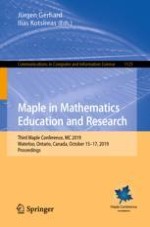2020 | Book
Maple in Mathematics Education and Research
Third Maple Conference, MC 2019, Waterloo, Ontario, Canada, October 15–17, 2019, Proceedings
Editors: Jürgen Gerhard, Prof. Ilias Kotsireas
Publisher: Springer International Publishing
Book Series : Communications in Computer and Information Science
